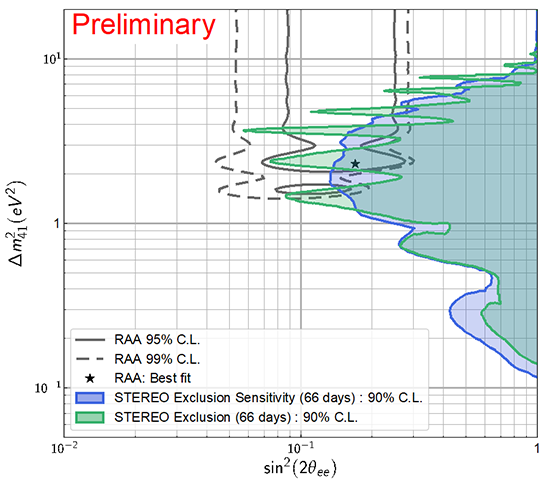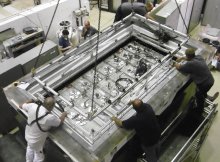STEREO experiment plays hide-and-seek with the fourth neutrino
The STEREO experiment just released its first physics results. A significant part of the most likely parameter space for a hypothetical 4th neutrino is now excluded.
Neutrinos are among the most abundant particles in the Universe, but also notoriously hard-to-detect elementary particles. They are produced in the core of stars, at particle accelerators, in very high energy phenomena or – as in STEREO – in nuclear reactor cores. Neutrinos do not carry any electric charge and only rarely do they interact with matter. Nowadays, we know of three types: electron neutrinos, muon neutrinos and tau neutrinos. The 20-year old astonishing discovery that neutrinos change type while travelling was awarded the 2015 Nobel Prize.
Are there more than 3 neutrinos? This question was revived in 2011, when researchers noticed that two so far unexplained experimental results could be reconciled if a 4th neutrino existed. With a mass of about 1 eV, this hypothetical particle known as “sterile” neutrino would be heavier than the 3 known neutrino types. Several experiments were designed, among which STEREO, to test the existence of this hypothetical 4th neutrino, and are currently under way.

Collecting data since November 2016, STEREO is a Franco-German experiment observing neutrinos produced by the nuclear reactor of the Laue-Langevin Institute in Grenoble. The experiment was created and is operated by researchers and technicians from the Irfu-CEA Saclay, the Institut Laue-Langevin (ILL), the Annecy’s Particle Physics Laboratory (LAPP), the Grenoble’s Subatomic Physics and Cosmology Laboratory (LPSC) and the Max-Planck-Institut für Kernphysik in Heidelberg, Germany (MPIK).
The Annecy’s Particle Physics Laboratory (LAPP, Savoie Mont Blanc University/CNRS-IN2P3) took charge of some of the detector’s protection against background noise (lead shielding), the mechanical frame supporting the shields and facilitating the movement of the detector’s experiment and calibration system. LAPP physicists are also involved in data mining and analysis.
STEREO scientists continue to collect data (4 times more data expected by the end of 2019), which will allow them to improve the accuracy of their results. Their measurement of the spectrum of the neutrinos emitted by the reactor, highly enriched in 235U, is also an important element for all the neutrino experiments with the reactors, and is eagerly awaited by the community.
1 Phys. Rev. D83 (2011) 073006
More information:
- Contact: Pablo Del Amo Sanchez, Head of the STEREO project at LAPP
- D. Lhuillier presentation at the 53rd “Rencontres de Moriond EW” : https://indico.in2p3.fr/event/16579/contributions/60857/attachments/47355/59539/01_Lhuillier_Moriond2018_.pdf
- Thumbnail picture: Insertion of the calibration system around the STEREO detector


